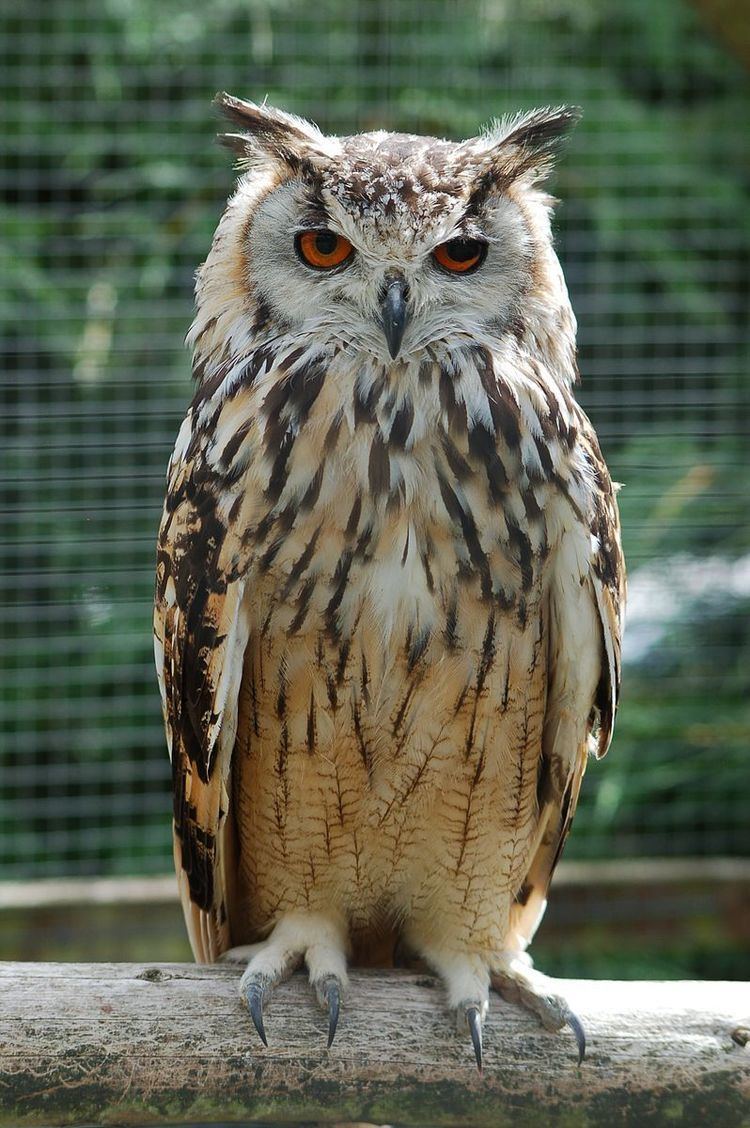Class Aves Infraclass Neognathae | Phylum Chordata Subclass Neornithes Superorder Neoaves | |
 | ||
The American (North and South America) horned owls and the Old World eagle-owls make up the genus Bubo, at least as traditionally described. The genus name Bubo is Latin for the Eurasian eagle-owl.
Contents
This genus, depending on definition, contains about one or two dozen species of typical owls (family Strigidae) and is found in many parts of the world. Some of the largest living Strigiformes are in Bubo. Traditionally, only owls with ear-tufts were included in this genus, but that is no longer the case.
Systematics
Mitochondrial DNA (mtDNA) cytochrome b sequence data supports the decision to consider the snowy owl an eagle-owl adapted to Arctic conditions and moving it into Bubo, rendering the monotypic genus Nyctea invalid.
The four fish-owls previously in the genus Ketupa were provisionally moved into Bubo as well. However, the mtDNA cytochrome b data suggests that in this case, to make Bubo monophyletic the Scotopelia fishing owls would also need to be included there. On the other hand, the genus then becomes quite large and ill-defined, and Bubo in the expanded sense seems to consist of two distinct clades. Thus, the fish and fishing owls can alternatively be united in Ketupa if some aberrant eagle-owls – at least the barred, spot-bellied and Usambara eagle-owls, perhaps also Fraser's eagle-owl and maybe others – are moved into that genus too. As some enigmatic eagle-owls remain essentially unstudied and others – e.g. Verreaux's eagle-owl – are of unresolved relationships, more research is needed.
Living species
The following living owls are usually included in Bubo:
The fish owls and fishing owls are:
Fossil record
Named and distinct Bubo species are:
Some notable undescribed fossils of prehistoric horned owls, usually quite fragmentary remains, have also been recorded:
Specimen UMMP V31030, a Late Pliocene coracoid from the Rexroad Formation of Kansas (USA), cannot be conclusively assigned to either the present genus or Strix. This fossil is from a taxon similar in size to the great horned owl (B. virginianus) or the great grey owl (S. nebulosa).
The Sinclair owl (Bubo sinclairi) from Late Pleistocene California may have been a paleosubspecies of the great horned owl, while the roughly contemporary Bubo insularis of the central and eastern Mediterranean has been considered a junior synonym of a brown fish owl paleosubspecies. Additional paleosubspecies are discussed on the appropriate species page.
Several presumed Bubo fossils have turned out to be from different birds. The Late Eocene/Early Oligocene eared owls "Bubo" incertus and "Bubo" arvernensis are now placed in the fossil barn-owl genera Nocturnavis and Necrobyas, respectively. "Bubo" leptosteus is now recognized as primitive owl in the genus Minerva (formerly Protostrix). "Bubo" poirreiri from the Late Oligocene or Early Miocene of Saint-Gérard-le-Puy in France, is now placed in Mioglaux.
On the other hand, the supposed fossil heron "Ardea" lignitum from the Late Pliocene of Plaue-Rippersroda (Germany) was apparently an owl and close to Bubo or more probably actually belongs here. Given its age–about 2 million years ago or so–it is usually included in the Eurasian eagle-owl today.
Interactions with humans
Because of their nocturnal habits, most owls do not directly interact with humans to a large extent, although they do capture many rodents and other pests. However, in 2015, an eagle owl in Purmerend, Netherlands, attacked some fifty humans before it was caught by a hired falconer.
